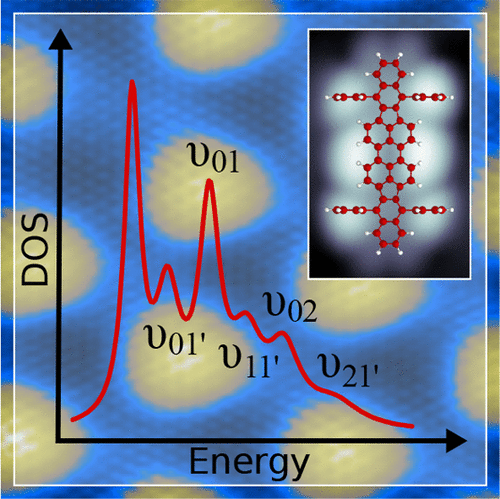当前位置:
X-MOL 学术
›
J. Phys. Chem. Lett.
›
论文详情
Our official English website, www.x-mol.net, welcomes your feedback! (Note: you will need to create a separate account there.)
Dissimilar Decoupling Behavior of Two-Dimensional Materials on Metal Surfaces.
The Journal of Physical Chemistry Letters ( IF 5.7 ) Pub Date : 2020-06-09 , DOI: 10.1021/acs.jpclett.0c01320 Alexander Mehler 1 , Nicolas Néel 1 , Jörg Kröger 1
The Journal of Physical Chemistry Letters ( IF 5.7 ) Pub Date : 2020-06-09 , DOI: 10.1021/acs.jpclett.0c01320 Alexander Mehler 1 , Nicolas Néel 1 , Jörg Kröger 1
Affiliation

|
The efficiency of hexagonal boron nitride and graphene to separate the hydrocarbon molecule C64H36 from Ru(0001) and Pt(111) surfaces is explored in low-temperature scanning tunneling microscopy and spectroscopy experiments. Both 2D materials enable the observation of the Franck–Condon effect in both frontier orbitals. On hexagonal boron nitride, vibronic progression with two vibrational energies gives rise to sharp orbital sidebands that are clearly visible up to the second order of the vibrational quantum number with different Huang–Rhys factors. In contrast, on graphene, orbital and vibronic spectroscopic signatures exhibit broad line shapes, with the second-order progression being hardly discriminable. Only a single vibrational quantum energy leaves its fingerprint in the Franck–Condon spectrum.
中文翻译:

二维材料在金属表面上的不同解耦行为。
六方氮化硼和石墨烯分离烃分子C 64 H 36的效率在低温扫描隧道显微镜和光谱实验中探索了Ru(0001)和Pt(111)表面的铜。两种2D材料都可以观察两个前沿轨道上的弗兰克-康登效应。在六方氮化硼上,具有两个振动能量的振动电子级数产生了清晰的轨道边带,这些边带清晰可见,直至具有不同Huang-Rhys因子的振动量子数的二阶。相比之下,在石墨烯上,轨道和振动光谱的签名显示出宽的线形,很难分辨其二阶进展。只有单个振动量子能在Franck-Condon光谱中留下指纹。
更新日期:2020-07-02
中文翻译:

二维材料在金属表面上的不同解耦行为。
六方氮化硼和石墨烯分离烃分子C 64 H 36的效率在低温扫描隧道显微镜和光谱实验中探索了Ru(0001)和Pt(111)表面的铜。两种2D材料都可以观察两个前沿轨道上的弗兰克-康登效应。在六方氮化硼上,具有两个振动能量的振动电子级数产生了清晰的轨道边带,这些边带清晰可见,直至具有不同Huang-Rhys因子的振动量子数的二阶。相比之下,在石墨烯上,轨道和振动光谱的签名显示出宽的线形,很难分辨其二阶进展。只有单个振动量子能在Franck-Condon光谱中留下指纹。



























 京公网安备 11010802027423号
京公网安备 11010802027423号